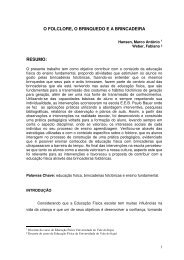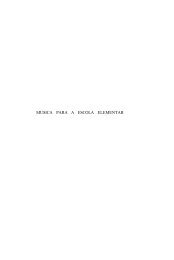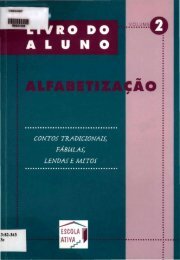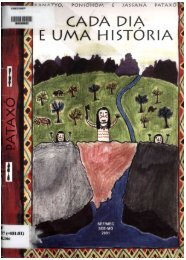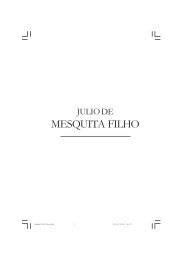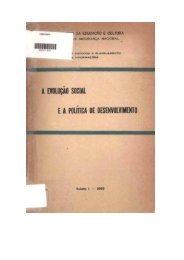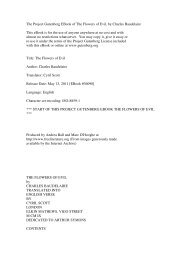A History of English Literature
A History of English Literature
A History of English Literature
You also want an ePaper? Increase the reach of your titles
YUMPU automatically turns print PDFs into web optimized ePapers that Google loves.
story; (3) a Rising Action; (4) a Main Climax. Sometimes (generally, in<br />
Comedy) the Main Climax is identical with the Outcome; sometimes (regularly<br />
in Tragedy) the Main Climax is a turning point and comes near the middle <strong>of</strong><br />
the story. In that case it really marks the beginning <strong>of</strong> the success <strong>of</strong> the<br />
side which is to be victorious at the end (in Tragedy the side opposed to<br />
the hero) and it initiates (5) a Falling Action, corresponding to the<br />
Rising Action, and sometimes <strong>of</strong> much the same length, wherein the losing<br />
side struggles to maintain itself. After (6) the Outcome, may come (7) a<br />
brief tranquilizing Conclusion. The Antecedent Action is that part <strong>of</strong> the<br />
characters' experiences which precedes the events <strong>of</strong> the story. If it has a<br />
bearing, information about it must be given either in the Introduction or<br />
incidentally later on. Sometimes, however, the structure just indicated may<br />
not be followed; a story may begin in the middle, and the earlier part may<br />
be told later on in retrospect, or incidentally indicated, like the<br />
Antecedent Action.<br />
If in any narrative there is one or more Secondary Action, a story which<br />
might be separated from the Main Action and viewed as complete in itself,<br />
criticism should always ask whether the Main and Secondary Actions are<br />
properly unified. In the strictest theory there should be an essential<br />
connection between them; for instance, they may illustrate different and<br />
perhaps contrasting aspects <strong>of</strong> the general theme. Often, however, an author<br />
introduces a Secondary Action merely for the sake <strong>of</strong> variety or to increase<br />
the breadth <strong>of</strong> his picture--in order to present a whole section <strong>of</strong> society<br />
instead <strong>of</strong> one narrow stratum or group. In such cases, he must generally be<br />
judged to have succeeded if he has established an apparent unity, say by<br />
mingling the same characters in the two actions, so that readers are not<br />
readily conscious <strong>of</strong> the lack <strong>of</strong> real structural unity.<br />
Other things to be considered in narrative are: Movement, which, unless for<br />
special reasons, should be rapid, at least not slow and broken; Suspense;<br />
general Interest; and the questions whether or not there are good<br />
situations and good minor climaxes, contributing to the interest; and<br />
whether or not motivation is good, apart from that which results from<br />
character, that is whether events are properly represented as happening in<br />
accordance with the law <strong>of</strong> cause and effect which inexorably governs actual<br />
life. But it must always be remembered that in such writing as Comedy and<br />
Romance the strict rules <strong>of</strong> motivation must be relaxed, and indeed in all<br />
literature, even in Tragedy, the idealization, condensation, and<br />
heightening which are the proper methods <strong>of</strong> Art require them to be slightly<br />
modified.<br />
DESCRIPTIVE POWER. Usually secondary in appearance but <strong>of</strong> vital artistic<br />
importance, is the author's power <strong>of</strong> description, <strong>of</strong> picturing both the<br />
appearance <strong>of</strong> his characters and the scenes which make his background and<br />
help to give the tone <strong>of</strong> his work. Perhaps four subjects <strong>of</strong> description may<br />
be distinguished: 1. External Nature. Here such questions as the following<br />
are <strong>of</strong> varying importance, according to the character and purpose <strong>of</strong> the<br />
work: Does the author know and care for Nature and frequently introduce<br />
descriptions? Are the descriptions concrete and accurate, or on the other<br />
hand purposely general (impressionistic) or carelessly superficial? Do they<br />
give fine variations <strong>of</strong> appearance and impression, such as delicate<br />
shiftings <strong>of</strong> light and shade and delicate tones <strong>of</strong> color? Are they<br />
powerfully sensuous, that is do they appeal strongly to the physical<br />
senses, <strong>of</strong> sight (color, light, and movement), sound (including music),<br />
smell, taste, touch, and general physical sensation? How great is their<br />
variety? Do they deal with many parts <strong>of</strong> Nature, for example the sea,<br />
mountains, plains, forests, and clouds? Is the love <strong>of</strong> external beauty a<br />
passion with the author? What is the author's attitude toward Nature--(1)





